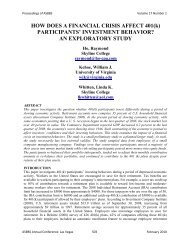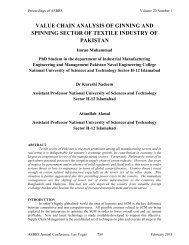stock repurchase announcements: a test of market ... - Asbbs.org
stock repurchase announcements: a test of market ... - Asbbs.org
stock repurchase announcements: a test of market ... - Asbbs.org
You also want an ePaper? Increase the reach of your titles
YUMPU automatically turns print PDFs into web optimized ePapers that Google loves.
Publishing in Management Journals<br />
So, the problem is not research productivity, but its implications. Beyond the understanding that research<br />
activity can hamper teaching effectiveness, there st ill exist issues that plague faculty m embers. Our<br />
experience is that there appear to be ample outlets in term s <strong>of</strong> both conferences and journals for the<br />
presentation and publicati on <strong>of</strong> our scholarship. So, getting published is not the problem . Although we<br />
agree with the argu ment that scholarship is critical to effective teaching (Nelson, 2004), we also submit<br />
that it be r espectable scholarship. As previously stated, the potential exists for publishing to be<br />
accomplished irrespective <strong>of</strong> scholarship, which relegates publications to the status <strong>of</strong> commodities. If we<br />
accept that only the best scholarship gets published in top-tier journals, then less than the best scholarship<br />
gets publishe d in lesser known journa ls. This begs the question, what is the objective <strong>of</strong> publ ishing<br />
something that does not get read?<br />
The argument that scholarship is critical to effectiv e teaching rests on effective scholarship. The reviews<br />
above and t he evidence below suggest that onl y the top schools will consistently publish effective<br />
scholarship simply because they have the resources to do so. Although it is not the objective <strong>of</strong> this study<br />
to prescribe t enure and prom otion policy, it is reasonabl e to conclude that faculty at traditional teaching<br />
schools should be rewarded for the consu mption <strong>of</strong> published research, as opposed to the p roduction <strong>of</strong><br />
peer-reviewed publications. The proba bility <strong>of</strong> great numbers <strong>of</strong> teaching faculty publishing in journals<br />
with high circulation rates is low. The remainder <strong>of</strong> this paper shows the evidence for that.<br />
METHODOLOGY<br />
The methodology cited he re is the same as that used in our previous study (Fekula & Horn yak, 2007)<br />
since the database is the same for both analyses. Portions <strong>of</strong> the methodology text are taken verbatim from<br />
the previous study when there is no bet ter way to state the method. Based upon circulation rates, the 10<br />
journals examined in this study represent thre e di stinct tier s <strong>of</strong> prestig e a s follow: (a) Ti er 1:<br />
Administrative Science Quarterly, Academy <strong>of</strong> Management Journal, and Academy <strong>of</strong> Management<br />
Review; (b) Tier 2: Journal <strong>of</strong> Management, Journal <strong>of</strong> Applied Behavioral Science, Human Relations,<br />
and Journal <strong>of</strong> Management Inquiry; (c) Tier 3: Business and Society, Group and Organization<br />
Management, and Organization Science.<br />
The journals cover the five-y ear period from 2000 through 20 04. The top 100 periodic als listed in<br />
Emerald Management Reviews (2004) were reviewed to first de termine which qualified as scholarly<br />
journals. Ne xt, journals were selected to ensure th at they represented the fiel d <strong>of</strong> general manage ment.<br />
Then journals were chosen based upon the level <strong>of</strong> prestige determined by the authors’ experience with<br />
the journals, as well as their knowledge <strong>of</strong> the views <strong>of</strong> other pr<strong>of</strong>essors in the management field. In order<br />
to collect data in a reasonable amount <strong>of</strong> time, the journals were also chosen based upon their availability<br />
in electronic form . The final selection criterion was to ensure that enough j ournals were chosen to<br />
reasonably represent three possible tiers <strong>of</strong> prestige. Although various criteria such as acceptance rate,<br />
numbers and types <strong>of</strong> reviewers, frequency <strong>of</strong> publishing, and circulation (Cabell’s, 2001) could be used,<br />
ultimately the authors ch ose circulatio n rate as th e criteria for tier assignment because t here is l ess<br />
variance reported for that measure. The chosen journals fell clearly into the three circulation categories to<br />
yield three tiers. Tier 1 journals ra nge from 10 to 25 thousand copi es circulated, Tier 2 from three to four<br />
thousand copies, and Tier 3 from one to two thousand copies (Fekula & Hornyak, 2007).<br />
After the journals wer e chosen the following data w as recorded by reviewing each journal article or its<br />
tables <strong>of</strong> contents: journal title, date, volume, author last name and first initial, and the affiliation <strong>of</strong> each<br />
author. In some cases, affiliations were unavailable and the researchers searched the internet to determine<br />
the affiliation <strong>of</strong> an author.<br />
The data was then coded and input to a spreadsheet as follows: (a) each journal date and volum e wa s<br />
given a unique identifier; (b) Each au thor’s name and affiliation were entered; (c) First authors were<br />
coded as such; (d) Su bsequent authors were coded as such, but only first authors were given a specific<br />
ASBBS E-Journal, Volume 4, No.1, 2008<br />
34

















